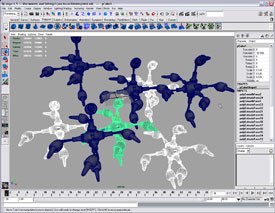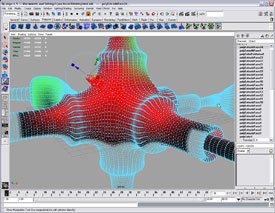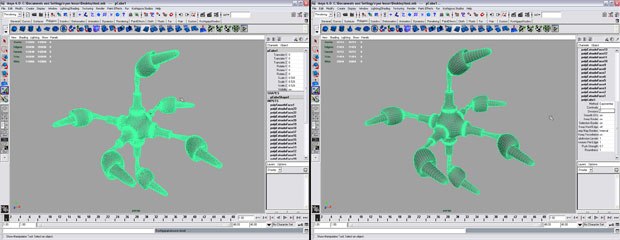Mary Ann Skweres examines the connections between the visual effects industry and medical visualization.

Though the box looks the same, Maya 6.5 has made various improvements over Maya 6. All images © Alias Systems Inc.
Recently, Alias released a new revision to the Maya product line, bringing it to version 6.5 in both the Unlimited and Complete packages (the last upgrade for IRIX and intended to handle very large datasets), while leaving the Personal Learning Edition (PLE) at version 6.0. This new release has been greeted with mixed responses from the 3D community for a variety of reasons and I hope to shed some light on them in this review.
Looking on the Alias website at the list of improvements for this release, you will find that a large percentage of the changes are performance optimizations. The list of enhancements seemed underwhelming so I loaded Maya 6.5 on two machines, each containing Maya 6.0 and 6.5. Since many of these improvements are speed-based, I thought that I would do my own speed checks. I am no benchmark-techie, but I figured if this upgrade was primarily speed boostsit would be noticeable to the typical user. The two test machines were a homemade dual 2 gigahertz Athlon with 2 gigs of ram and an NVIDIA FX Quadro 900 and a Dell M60 with a 1.6 gigahertz P4M with 512 megabytes of ram and an NVIDIA Quadro FX Go700.
I tested many of the improvements, including general viewport workflow, vertex painting, editing polygonal objects that contain vertex painting, soft modification of high poly models, subdivision surface editing and many others.
In general, I found no noticeable improvements over performance on either machine when using the same files in Maya 6.0 and 6.5. There were, however, some cases where these speed improvements were noticeable. Here are some of those cases:
I created a simple 3D shape using polys and applied a Smooth to it. I noticed that on the laptop, 6.5 completed the smooth quicker than 6.0but noticed nothing obvious on the desktop dual cpu. I also took that object and bumped it from a Smooth setting of 3 (72,000 triangles) to 4 (286,000) and noticed slightly quicker redraw and viewport interactivity in 6.5. Now, drawing one object with x amount of polys is actually different from drawing many objects with the same total polycount, so I tried that too. Here you can see many unique objects adding up to similar polycounts. In this case, I saw almost no difference on either machine.

Many unique objects add up to similar polycounts.
Alias suggests that using Soft Modification on high-density models now has improved performance. On the mesh that I tested I did see a little performance boost; however, neither version of Maya produced acceptable results. This is partially Maya and partially my machine hardwarebut there you go. I also tested poly beveling on a high-density mesh with vertex colors painted on, which was an additional stated improvementbut saw no speed increase here either.
Meanwhile, there is a small smattering of additions, some more significant than others. mental ray for Maya was revved to 3.4, Maya Satellite adds network rendering capability (other packages have had this for ages), Scene Segmentation allows multiple users to work on the same file in parallel (again, already available in other packages). Plus, there are a few new additions to the polygon bevel tool that create cleaner results in a more flexible way.

Example of poly beveling on a high-density mesh with vertex colors painted on.
As a professional game developer, I found this release to be relatively shallow. While I am all for general speed and performance enhancements to the overall workflow of a product, I do not think this warrants a whole new release costing $899 for the Complete upgrade and $1,249 for the Unlimited upgrade. I understand that sometimes these intermediate releases are not quite as significant as major full upgrades, but this could have realistically been either a free release or accompanied by a host of actual tool improvements and inventions that wouldve made for a pretty solid release.
Ryan Lesser teaches animation at his alma mater, the Rhode Island School of Design (RISD). His animation company (Mammoth Studios) has worked on projects for Phish, Sony, MTV, De La Soul, Madison Square Garden and others. Since 1999, Ryan has served as art director at Harmonix, a Playstation2 and Xbox videogame developer. Here he has helped produce award-winning games such as Frequency, Amplitude and the Karaoke Revolution series. Ryan also maintains a Providence, Rhode Island-only underground music site, lotsofnoise.com.








